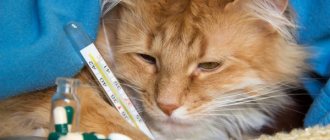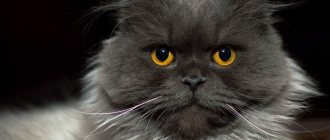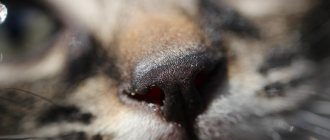When a cat's eyes are watery, it is better to go to the veterinarian, as this is most likely conjunctivitis. Conjunctivitis in cats is a fairly common disease that occurs not only in animals walking outside the home. Moreover, eye inflammation is a harbinger of various infectious diseases. In our article we will try to reveal the main causes, symptoms and treatment of this disease, and also talk about the main preventive methods.
Causes of conjunctivitis in cats
The main reasons are:
- Foreign bodies that get into the pet's eyes (this can be dust, wood chips, sand, or other objects that can damage the eye).
- Getting various chemicals and household substances into the eye - this can happen while swimming.
- Conjunctivitis in cats is often caused by a herpesvirus infection that affects the mucous membranes of the eyes and nasal cavity - in such cases, viral conjunctivitis occurs.
- One of the reasons may be the transfer of inflammation from nearby tissues, such as the skin of the eyelids (blepharitis), the mucous membrane of the nasal cavity (rhinitis).
- Acute infectious diseases that cause various complications, including conjunctivitis - carnivore plague, rhinotracheitis, panleukopenia.
- Chlamydia and mycoplasmosis, and other bacterial infections can also cause conjunctivitis.
- Injuries received during play or fights with other animals open the gates for the development of inflammation.
- Surprisingly, cats, like humans, can suffer from allergies to pollen, dust, perfumes and food - these can also serve as catalysts for illness.
Main reasons
There are many reasons for the development of eye inflammation:
- Mechanical causes are eye injuries, the presence of foreign bodies.
- Chemical causes are irritation resulting from contact with gases, vapors, and acids.
- Infectious causes.
- Transition of the inflammatory process from one area to another.
- Allergens. A similar illness can arise from plant pollen or the host’s new perfume. In this case, it is necessary to observe what factor caused the irritation and eliminate it from everyday life.
Unfortunately, many owners, having discovered conjunctivitis in a kitten, are in no hurry to treat it at the veterinarian, but this ailment can be a harbinger of a serious infectious disease, and this cannot be done without consulting a veterinarian.
Symptoms of conjunctivitis in cats
The clinical manifestations of conjunctivitis depend on the course of the disease:
- the acute course is accompanied by the sudden onset and clear clinical signs of inflammation with copious discharge;
- subacute clinical course is slightly weaker than acute;
- The chronic course is characterized by slow development, long course and mild clinical manifestations.
General symptoms of all conjunctivitis in cats:
- Redness of the mucous membranes of the eyes;
- Swelling of the eyelids;
- Cats have watery eyes;
- Discharge from the eyes - from mucous to yellow-green purulent;
- Constant attempts by the cat to “wash” the eyes;
- Souring of the eyes after sleep, sticking with dried pus;
- Pain when blinking, squinting, fear of light;
- Sometimes a cloudy film on the cornea is visible.
Symptoms
What does the owner of a cat with conjunctivitis notice?
The visible tissues of the eye of such a cat are increased in volume (edema), reddened (hyperemia), and there is a path towards the nose (exudation).
It is a mistake to assume that by the appearance and quality of discharge from the eye or from a photo one can immediately determine the cause of symptoms, because in the eye there are normally a lot of microorganisms with which local immunity constantly interacts, and if any pathology occurs in a cat, their active growth begins , and this process can confuse the clinical picture (not every purulent conjunctivitis is infectious, for example).
Types of conjunctivitis
There are the following types of this disease:
- Catarrhal conjunctivitis
is the most harmless and easily occurring. In this case, the eye is red, the mucous membrane swells somewhat, and the animal experiences pain when trying to open its eyes. They are constantly crying. The temperature usually remains within normal limits. Sometimes, with severe injuries, protrusion of the edematous conjunctiva in the form of a roller from under the eyelids is observed. - Purulent conjunctivitis
occurs when the infection has already completely spread in the eye. It is quite difficult to overlook such an ailment, since this form of the disease has obvious signs in the form of yellow or green discharge. The inflamed eye does not open at all. The general condition of the cat is depressed (lethargic), the local temperature is increased, the eyelids are swollen, the mucous membrane is red. The pet develops photophobia. The discharge from the eyes is first liquid, then thick, gray-yellowish and accumulates on the edge of the eyelids, forming crusts. - Follicular conjunctivitis
is a dangerous and life-threatening type of inflammation. In this case, the infection penetrates lower and affects the lymphatic follicles. The eye increases in size. After diagnosis, the doctor prescribes serious treatment, which may include surgical intervention. This type of conjunctivitis in cats is often caused by mechanical irritants (foreign bodies, dust) or occurs as a complication of infectious diseases. It develops slowly, accompanied by minor mucopurulent discharge. On the inner surface of the third eyelid there is a cluster of enlarged follicles of a dark red color, resembling ripe raspberries in appearance. Typically, both eyes are affected at the same time. - Phlegmonous conjunctivitis
is a complex type of inflammation. In this case, conjunctivitis affects not only the surface of the mucous membrane, but also the inside of the eye. It is quite difficult to save them, but with timely rehabilitation it is quite possible. This type of disease is characterized by a ring-shaped protrusion of the conjunctiva through the palpebral fissure. The surface of the conjunctiva itself is glassy, shiny and lumpy, bright red. Then the cat may develop bleeding ulcers. Serous-mucous or purulent discharge is also noted. - Allergic conjunctivitis
is a complication of an allergic reaction, most often due to feeding inappropriate food. If your cat has watery eyes, you should take the animal to the veterinarian, as there is a possibility of infection.
Sources
There are many factors that can provoke the development of an inflammatory process in the conjunctiva in a cat. Let's look at the main reasons.
Viruses, germs and fungi
One of the most common causes of conjunctivitis. You can easily judge the health of an animal by its eyes. Almost any viral or bacterial disease leads to the development of inflammation of the conjunctiva. In case of fungal diseases, the pathogen settles on the mucous membrane itself and affects it. It is much more difficult to treat a disease caused by fungi.
Allergic reaction
The formation of allergic conjunctivitis is also observed quite often. In the situation with pets, as with people, similar symptoms are observed with allergies.
An allergic reaction manifests itself in the form of a runny nose, sneezing, itching, sore throat or ears, as well as excessive lacrimation. There is redness, swelling and itching of the conjunctiva. You can get rid of this form of the disease only after eliminating the signs of an allergic reaction in the cat.
In this case, you will need to determine the irritant and completely get rid of it, and the animal will need treatment.
Mechanical damage
Even the slightest damage can cause infection. To prevent this phenomenon, the glands produce tears in large quantities. Thanks to this, the “concentration” of microbes decreases, but it will not be possible to completely get rid of them in this way. Over time, some pathogenic bacteria can reach the wound.
As a result, the cat develops inflammation of the conjunctiva.
Any injury to the eye, be it a wound on the eyelid or on the eyeball itself, is dangerous. There is a risk of vision loss in both the first and second cases.
Chemicals
In such a situation, the development of catarrhal conjunctivitis in a cat is observed due to the contact of chemical vapors with the mucous membranes. A burn to the conjunctiva is more dangerous because it can cause the animal to go blind if it does not react immediately.
Thanks to its natural curiosity, the cat, noticing that some container with chemicals is open, will begin to sniff it. If it comes to researching powdered chemistry, the possibility of “getting” inflammation of the conjunctiva increases.
In this case, the causative agent of the disease will be small particles of the product, acting as a foreign body in the eyes, which leads to damage to the mucous membrane.
Irradiation
Both X-ray and radioactive radiation, as well as ultraviolet radiation, can harm the eyes of an animal. Cats should be protected from any kind.
Owners of terrariums that use ultraviolet lamps should take into account that such irradiation is harmful to both animals and humans.
In addition, girls also need to be careful, often purchasing special ultraviolet devices to polymerize gel polish at home. When this machine operates, it emits violet light that attracts your pet.
If you watch the light for a long time, problems with the conjunctiva will appear very quickly.
Be sure to read the article about other eye diseases in cats so as not to confuse conjunctivitis with anything.
Diagnosis of the disease
In order to accurately establish a diagnosis, a number of conditions must be met, such as collecting primary data to establish the cause (history), which includes clarifying a number of questions: whether the animal is vaccinated regularly annually, whether there was contact with other animals that looked sick. Redness occurs in one eye or both. How long ago did the owners notice, are there any other changes, what is the nature of the discharge from the eyes, etc. Then the doctor must look at the eyes using special instruments. If necessary, blood biochemistry and infectious diseases tests, bacteriological studies, and cytological studies of scrapings from the conjunctiva are taken.
Treatment of inflammation of the conjunctiva in pets
This disease in cats can be cured at home. An animal with this disease is hospitalized in rare cases.
Washing
Initially, the eyes are freed from mucous and purulent discharge, and the crust is removed. Rinsing with a decoction of calendula or chamomile will help with this, or you should use furatsilin in the form of a solution (1 tablet diluted in a glass of water). Cotton wool provokes irritation of the mucous membrane, so it is better to use a bandage. Each eye is washed with a separate swab.
The solution is brought to body temperature before the procedure. It is risky to use potassium permanganate and boric acid. This will cause a burn if the dose is incorrect or if the particles of the substance are not completely dissolved.
Eye ointments
At an early stage, drugs for external use are prescribed. An ointment containing an antibiotic is applied behind the lower eyelid 4 times during the day.
The medicine is applied using a glass rod with a rounded tip; before starting the procedure, you need to hold it in hot water.
The most effective remedies from this group:
- Erythromycin;
- Tetracycline;
- Phloxal.
Drops
Eye drops for the treatment of conjunctivitis are used up to 8 times throughout the day. Typically prescribed use:
- Colbiocin;
- Maxitropa;
- Eubitala;
- Iris;
- Albucida;
- Dexamethasone;
- Moxifloxacin.
Both ointment and drops are applied to two eyes, even when the inflammatory process occurs in only one. Before starting the procedure, you should get rid of discharge and crusts by treating your eyes with an antiseptic liquid.
Intramuscular administration of antibiotics
If a severe form of conjunctivitis is diagnosed, antibiotics are prescribed to be injected into the muscle. This treatment is prescribed for purulent, parenchymal and follicular inflammation of the conjunctiva. Since antibiotics have side effects, they are administered under the supervision of a veterinarian.
As a rule, treatment is prescribed:
- Doxycycline;
- Ceftriaxone;
- Ciprovet (ciprofloxacin).
Antihistamines
Antihistamines are prescribed to treat allergic conjunctivitis.
Cats are prescribed the same medications as people, so the veterinarian must accurately determine the dose.
Typically, pets are prescribed:
- Zyrteca;
- Loratadine;
- Diazolina;
- Suprastina.
The medications are selected by the veterinarian taking into account the laboratory tests and the severity of the disease; self-medication is harmful to the health of the animal.
When the acute stage is removed, it is recommended to treat the mucous membranes with Solcoseryl eye gel.
The drug helps accelerate recovery processes in the conjunctiva after an illness. If there is no effect of treatment, the diagnosis is repeated and the treatment plan is changed.
Treatment of conjunctivitis in cats
It is quite difficult to treat sick cats with conjunctivitis, despite a significant arsenal of medications and methods of their use. Treatment for the disease depends on its type. Treatment of conjunctivitis in cats should be carried out under the supervision of a veterinarian. The choice of means depends, first of all, on the severity of the process and the type of conjunctivitis.
First, the animal's eyes must be cleaned of foreign secretions. This is done with cotton wool and a solution recommended by the doctor. Particular attention should be paid to the pouch, which is located near the animal’s eye. Feline conjunctivitis is a rather dangerous disease, and if the therapy is chosen incorrectly, the pet may lose its vision. It is worth remembering that during this period the animal’s immunity weakens, therefore it is extremely important to give it immunomodulators (subcutaneous FORVET is recommended).
Depending on the cause of the disease, the animal is prescribed antibacterial drops or ointments based on antibiotics, which help fight conjunctivitis, as well as local antiviral drugs to treat viral conjunctivitis, such as FORVET eye drops, one drop 4-5 times a day. If necessary, surgical intervention is performed to eliminate the causes (elimination of entropion, removal of the third eyelid).
Types of disease
Depending on the nature of the fluid separated from the eye, the following are distinguished:
- Catarrhal - the owner notices that tears and clear mucus are flowing from the eye. Very often, such conjunctivitis can later turn into the following type.
- Purulent conjunctivitis - pus discharges from the eye. It can be white, yellow, greenish, more or less thick. Often the eyelids are glued together with discharge, and there is a pronounced “path” to the nose. The fur around the eye may be sparse; the cat may scratch its face vigorously, trying to get rid of the thick pus covering the eye, and tear out pieces of fur.
Depending on the characteristics of the process, the following are distinguished:
- Chronic - usually this is a long-term process, the severity of symptoms may vary, the duration is measured in months or years, it can be lifelong;
- Subacute - several weeks or days, often accompanied by respiratory infections;
- Acute - several hours, typical for injuries.
Prevention of conjunctivitis
To prevent the development of conjunctivitis in your cat, you should follow a number of measures. For example:
- Try to carry out annual vaccinations and regularly give anthelmintics, since viruses and helminths can be the root cause of the disease.
- Support your pet's immune system with immunomodulatory agents.
- Protect the cat from getting foreign bodies and chemicals into the eyes. Clean more often, handle hygiene products carefully, and put household chemicals away.
- Limit your pet's contact with other animals, especially stray and obviously sick ones.
- Wash and disinfect your hands thoroughly after contact with sick animals before interacting with your pet.
Thus, conjunctivitis in cats is not uncommon. However, there is nothing to worry about; with timely treatment, you can get rid of the disease once and for all.
Prevention
It just seems that conjunctivitis is a simple disease that can be easily cured with eye drops. In fact, this is a common misconception that can lead to blindness in kittens. As you know, it is better to prevent a disease than to treat it, let's look at the main methods of prevention:
- Regular examinations by a veterinarian will help to avoid the presence of infectious diseases, the symptom of which may be eye inflammation.
- Vaccinations against herpes, chlamydia, and calcivirus play an important role.
- Daily eye care will help avoid such troubles.
It has been noticed that well-cared for pets do not suffer from conjunctivitis, that is, you need to love and care for the cat, and then it will delight the owner with an excellent mood and good mood.
Tips for beginners when washing eyes
Eye washing is one of the most important points in the treatment and prevention of disease in any animal.
You can do the procedure yourself at home or go to a veterinary clinic. During a period of illness, a cat is most often reluctant to allow its owner to approach it.
Representatives of the Persian, British and Siamese breeds are especially capricious. In this situation, it is advisable to ask a family member to hold the cat's head during the procedure. It is best to secure it with a towel or diaper.
Recommendations:
- A folded cotton pad or a tight tourniquet is suitable for rinsing. It is better to avoid cotton swabs, as they do not absorb liquid well, have a relatively small surface and can damage the retina when the animal tries to escape.
- For sterility purposes, it is better to prepare separate dishes for washing each eye. For the same reason, you should use a cotton pad no more than once.
- It is not recommended to touch the inflamed surface with a dry disc.
- Hands must be washed.
- All solutions must be at room temperature.
- Keep in mind that a swollen area can often cause pain for your cat.
- The best treatment is comprehensive. After rinsing with the solution/drops, re-treat the inflamed area with ointment.
- You need to repeat washing as often as possible. Step-by-step instructions for washing eyes
- Fix the animal on its side, turning its head up, holding the chin.
- If a crust forms and the eye sticks together, soften the inflamed area with Vaseline oil. Using cotton wool soaked in 3% hydrogen peroxide, remove the discharge, then rinse with the solution and apply eye drops.
- Apply the solution to the eyeball, gently lifting the eyelids.
- Raise and lower the animal's eyelids several times to distribute the medication evenly. Remove excess with a disc.
- Do not forget about nasal discharge, remove it with a cotton pad.
Treatment of chronic conjunctivitis
The goal of treatment is to eliminate the cause of the disease, block the mechanism of development of the pathology and restore the resistance and regenerative abilities of the body, as well as alleviate the discomfort of the disease:
- Destruction of the pathogen. Antibiotics are prescribed if the disease is caused by bacteria. Antiviral drugs are prescribed when the disease is caused by viruses. If the pathology develops due to worms, then anthelmintic drugs are prescribed.
- Eliminating the allergen. If the inflammation is of an allergic nature, then it is necessary to eliminate the allergen, and also prescribe antihistamines to the cat.
- will help block the mechanism of disease development . Dexamethasone is used as the main corticosteroid. Please note that violation of the dosage leads to destruction of the cornea, so these drugs are prescribed only by a doctor.
- To restore the body's resistance a diet enriched with vitamins and microelements is prescribed. It is possible to use immunostimulating drugs. At the same time, due to the weakness of the body, it is necessary to regularly do wet cleaning in the room.
- To eliminate discomfort from the disease, 2-3 drops of dicaine or novocaine (for pain relief) are instilled into each eye daily. Every day, in the morning and evening, the eyes are cleaned of exudate using a cotton swab; you can drop a decoction of chamomile or black tea into the eyes.
Reasons for the development of the disease
The causative agents of bacterial conjunctivitis are pathogenic and opportunistic microorganisms such as chlamydia, streptococci, staphylococci, Koch-Wicks bacteria and pneumococci .
Attention! In normal condition and with good immunity, such microorganisms can be present in the body for years and begin to have a negative effect on the conjunctival membrane of the eyes when exposed to the following unfavorable factors:
- weakening of the immune system with age;
- various anomalies of the upper and lower eyelids ;
- improper use of contact lenses (violation of maintenance rules and exceeding the period of their use), as well as wearing someone else's contact optics;
- mechanical and chemical eye injuries;
- dry eye syndrome, in which the tear film loses its protective qualities and integrity.
Is it possible to get infected?
You can get conjunctivitis from a cat, but only if it is viral or bacterial in nature. The main method of transmission is contact infection ; airborne transmission is also possible for viruses.
However, it is transmitted to humans quite rarely, since people and cats are usually affected by different strains of the pathogen, and this requires close contact, which does not happen often.
Conjunctivitis of allergic origin
Many people naively believe that allergies are “just” endless rhinitis and tears, a red nose and the inability to go outside when poplars are blooming. In fact, this is an extremely serious pathology, directly related to autoimmune diseases and fraught with very bad consequences, including death.
Pathogenesis and clinical manifestations
An allergy develops when the body responds inadequately to the entry of some antigen into it, and the latter can be all kinds of compounds, including pollen and many medicinal substances. In case of allergies, conjunctival tissues quickly swell due to the action of histamine, and lymphocytic infiltration occurs. In severe cases of an allergic reaction, inflammation develops. This is how allergic conjunctivitis begins. Its symptoms are not much different from the clinical picture of inflammation of viral etiology, but there are still differences:
- It all starts with a sudden allergic reaction.
- After its elimination, the animal’s condition seems to stabilize, but the eyelids and conjunctiva remain somewhat swollen.
- After a few hours, the organs become noticeably red, and the hyperemia gradually intensifies.
- After about a day, pronounced signs of inflammation appear, including copious discharge of exudate.
- If the animal is exposed to the same allergen (for example, eats another portion of food), its condition sharply worsens, the eyes swell so that the animal remains almost blind.
Therapeutic techniques
If you notice the onset of an allergic reaction in time, you can get by with “little blood.” The cat is urgently given a diphenhydramine tablet. It is more convenient to do this if you first crush the medicine to a powder state, mix it with a small amount of water and pour it down the pet’s throat using a syringe.
In general, in other cases the approach is similar: the cat is injected with the same diphenhydramine (but intramuscularly) and other sedatives. If the animal's condition is alarming, medications that stimulate respiratory and cardiac activity (at least caffeine-sodium benzoate) are also indicated. Ideally, it is necessary to identify the allergen that causes such a reaction and reliably protect the animal from its effects, but this can only be done with the help of an experienced veterinarian in a well-equipped clinic.
Parenchymal conjunctivitis
Parenchymal conjunctivitis is a type of pathology (the cause can be any of all of the above), which affects not only the conjunctiva, but also all adjacent organs and tissues . The clinical picture is appropriate:
- The conjunctiva is swollen and severely hyperemic.
- The eyelids are in the same condition, they are swollen, and when palpated, a strong pain reaction develops.
- Deep ulcerative lesions are visible on the cornea.
Treatment depends on the underlying cause, but anti-inflammatory corticosteroids are most often indicated. Most likely, the introduction of broad-spectrum antibiotics in loading doses will also be required.
Follicular type inflammation
Follicular conjunctivitis is even more severe. The exact causes and triggers of the disease have not been sufficiently studied. It is assumed that they may be the same as in the case of the eosinophilic variety (ie, autoimmune pathologies and allergic reactions). It is characterized by damage to the lymphatic follicles, as well as the conjunctiva itself.
This is a very, very serious pathology that requires immediate veterinary intervention!
The clinical picture is as follows:
- Large, reddish-gray plaques appear on the conjunctiva.
- The third eyelid becomes inflamed and droops downward. The same lesions as in the previous case are easily visible on it.
- Because of all of the above, the cat looks more like a Chinese cat. His eyelids are tightly closed; the pet can look at the world around him with great difficulty.
- The general condition can be very depressed, the cat refuses food, but drinks willingly.
Therapeutic techniques
First, as in the previous case, antihistamines and anti-inflammatory corticosteroids can be used. Sofradex has proven itself especially well . But you can’t do without “mechanical” therapy:
- The cat is given Auror blockade With this blockade, a warm 0.5% solution of novocaine is injected under the upper and lower eyelids. It is advisable to do this every other day.
- Every four days, using a cotton swab, you need to cauterize each follicle with a 10% solution of silver nitrate. This needs to be done as carefully (!) as possible, otherwise you can easily burn the cat’s entire cornea.
Twice a day, 1% tetracycline ointment is placed into the conjunctival cavity. In especially severe cases, they resort to removing the third eyelid.
Viral variety
Let's start with perhaps the most “general” root cause: viral conjunctivitis in animals is quite common. This is not just one disease, but a whole complex of them. The fact is that almost any viral infection can lead (and often does) to damage to the organs of vision.
Characteristics and pathogenesis
Most often, this pathology is a consequence of an animal being infected with the feline herpes virus (FHV-1). It spreads very quickly among pets as it can be transmitted through airborne droplets. When animals are kept crowded, livestock coverage often reaches 100%. Transmissible (through the bites of blood-sucking insects) infection is also possible. In 100% of cases, the entry of the FHV-1 virus into the body of an animal is accompanied by conjunctivitis, and signs of damage to the respiratory tract are possible. In quite rare cases, inflammatory and degenerative processes of the corneal layer are observed.
After entering the body, the virus replicates in the tissues of the trigeminal nerve. In some cases, the infection is completely asymptomatic for some time, with the exception, perhaps, of the cat’s eyes constantly sticking together in the morning (the edges of the eyelids are stuck together with dried exudate). Any stress or administration of certain types of medications (for example, corticosteroids) is fraught with the rapid development of the virus with the appearance of clearly visible clinical signs. However, a renewed disease usually proceeds much easier than a “classical” infection (after all, the body already has time to produce a certain amount of antibodies that suppress the pathogen), characterized by minor damage to the cornea, conjunctiva and/or respiratory system.
Again, not all is well. Often, recurrent cases of the disease are characterized by the cytolytic nature of the viral lesion, causing conjunctival or corneal ulceration to develop. Unfortunately, in such cases (as a rule) you should not hope for a complete recovery. Chronic conjunctivitis or (which is much worse) keratitis is possible. Subsequently, such animals often develop glaucoma.
Symptoms
In approximately 70% of cases, the initial damage to the organs of vision is one-sided (that is, the conjunctiva is inflamed in only one eye). Within a week, the disease spreads to the second eye (due to the fact that the cat constantly scratches and rubs the areas that bother him, spreading the pathogen). In cases where viral conjunctivitis remains untreated, the situation is fraught with follicular conjunctivitis. In addition, a cat may “formally” seem healthy, but in reality it will become a carrier of the disease and will constantly spread the virus in the external environment, contributing to the infection of other animals.
Note that the FHV-1 virus is relatively safe for young cats with well-developed immunity. In any case, the disease is extremely rarely diagnosed in pets under the age of five or six years. Let's summarize.
Conjunctivitis of viral origin in cats is characterized by the following symptoms (the description is true not only for FHV-1):
- The animal suddenly begins to cough and sneeze.
- The cat's eyes become swollen, the conjunctiva acquires a clearly visible, “juicy” reddish-blue hue.
- A thin exudate is constantly released from the conjunctival cavity, occasionally with a mucous consistency.
- In more advanced cases, ulcerative lesions appear on both the conjunctiva and the cornea.
Therapeutic techniques
Treatment of conjunctivitis in cats includes the use of systemic oral and parenteral antivirals and antibiotics. We list the most common and effective medications that have proven themselves in practice:
- The usual 1% tetracycline ointment , which should be placed in the conjunctival cavity twice a day for two weeks.
- Recent studies have shown that particularly high effectiveness is achieved with the combined use of ointment and orally administered doxycycline at a dose of 10 mg/kg. Give it once a day for two weeks. Please note that this antibiotic is extremely powerful, but at the same time very toxic. With long-term use, damage to the liver and kidneys is possible, so treatment must be carried out only under the supervision of an experienced veterinarian. Particular emphasis on the administration of doxycillin should be made when treating animals with pronounced signs of respiratory infection.
Breeders who are familiar with veterinary medicine first-hand may have a completely logical question: “Why prescribe antibiotics for a viral disease, since they are practically inactive against viruses?” Everything is correct. But still, antibacterial agents are extremely important, since their use helps prevent the development of secondary bacterial infections. However, this does not in any way eliminate the need to use special antiviral drugs. They must be given to the animal up to six times a day; the duration of the therapeutic course can also be up to two weeks. Most commonly used: Trifluridine 1%, idoxuridine 0.1% and vidarabine 3%.
Trifluridine has the most pronounced effectiveness and is able to penetrate directly into and under the corneal tissue. But it has one negative property - veterinarians have repeatedly noticed that cats often develop severe sensitivity to this drug. The drugs Idoxuridine and vidarabine are safer in this regard, but they are almost impossible to buy in retail pharmacies. If the veterinary clinic does not have them, then they simply will not be sold to the animal owner without a prescription and pre-order.
Chlamydial conjunctivitis
Chlamydial conjunctivitis stands apart. Its manifestations are in many ways similar to the bacterial variety, but the pathogen itself is quite specific and requires a special therapeutic approach. To begin with, inflammation of the conjunctiva in this case is only a consequence of systemic chlamydia.
Remember that this disease is transmitted to humans!
When caring for a sick animal, strict adherence to personal hygiene measures is necessary. If there are small children or elderly people in the house, it is advisable to treat the cat in a clinical setting.
The clinical picture is blurry:
- The eye swells, the conjunctiva is swollen and hyperemic.
- The development of purulent inflammation is possible; a lot of thick, jelly-like contents are released from the conjunctival cavity.
- Severe blepharospasm, due to which the cat cannot open its eyes.
- At the same time, the animal may cough and sneeze heavily (if the respiratory system is damaged).
For treatment, loading doses of Doxycillin at 10 mg per kilogram of live weight, the drug is administered once a day. The duration of therapy is at least three days, but five days is better. Treatment can be considered successful only after two negative test results for chlamydia. If the reaction is positive or questionable, the course of treatment is repeated.










